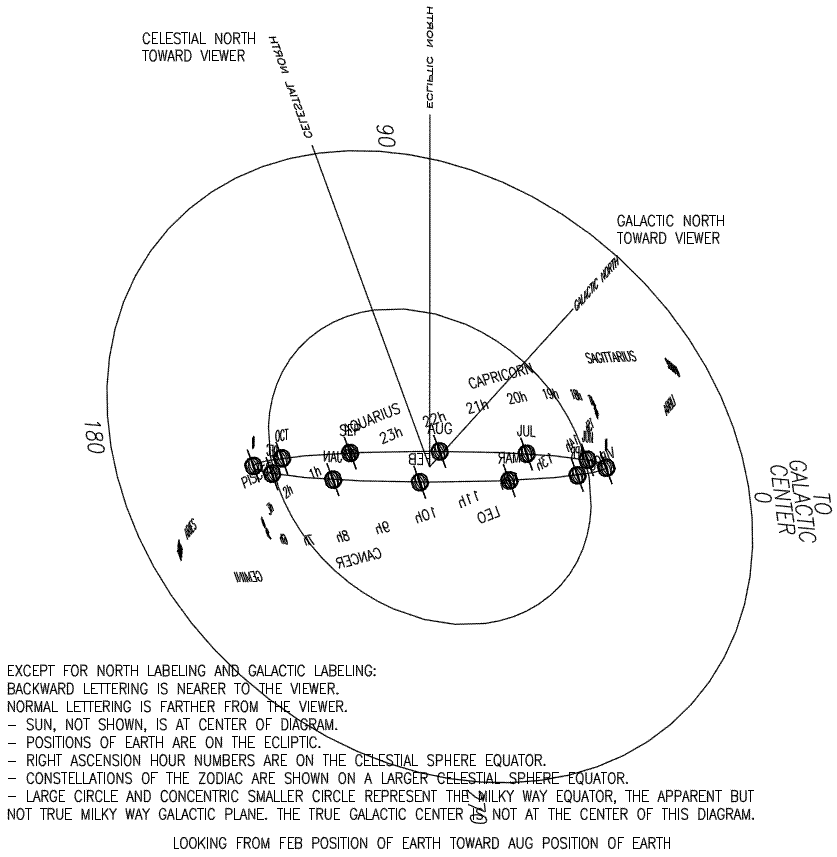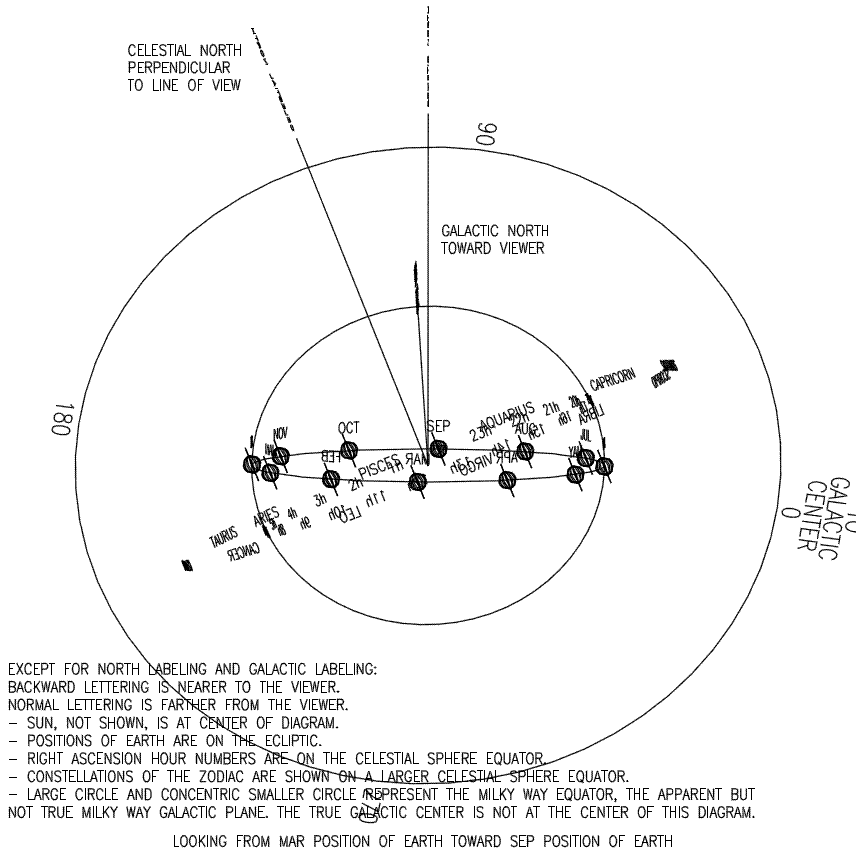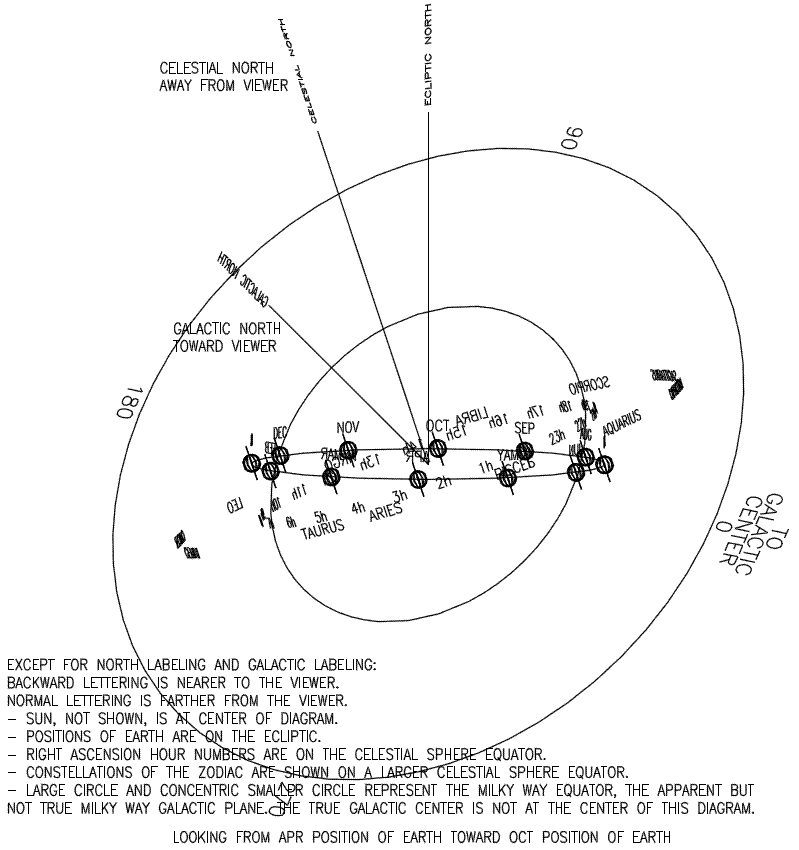
Milky Way and Solar System Orientation Diagram
These diagrams illustrate the orientation of the Milky Way and the Solar System.
Disclaimer: These diagrams illustrate concepts but they are not accurate in many ways. See notes near bottom of page. The more you learn, the more interesting it becomes.
I was unable to find an AutoCAD drawing of this, then I found it hard to find a geometric definition of both concepts (model of the Milky Way and model of the Solar System) in the same geometric model.
On 11/24/2011 I found the "Orientation of Astronomical Coordinates" diagram on Wikipedia page
http://en.wikipedia.org/wiki/Celestial_coordinate_system
The work below attempts to show the orbit of earth within that diagram.
Further, I wanted to illustrate the orientation of the earth and the Milky Way at every month of the year.
A pdf file of the image below (recommended):
073_celestial_ecliptic_galactic_angles_01.pdf

What are we looking at here?
Numbers or lettering that read backwards are nearer to your point of view.
Numbers or lettering that read normal are farther from your point of view.
We are looking at 3 systems and their north poles.
System 1 is the path of the earth and its position at 12 points during the year.
What is shown here is almost identical to what is known as the ecliptic, except the ecliptic is labeled by the apparent position of the sun and here I have labeled the position of the earth. The direction perpendicular to this system is ecliptic north.
System 2 is the celestial equator, the equator of the apparent sphere of stars that surrounds us, that appears to rotate about the earth's axis. The direction perpendicular to the celestial equator is celestial north.
System 3 is the galactic equator, the apparent equator of the Milky Way, although it is only apparent. The true central plane of the Milky Way is a bit south of our solar system and the true center of the Milky Way is hugely distant away, in the direction indicated by 0. The direction perpendicular to the galactic equator is galactic north.
The angle between ecliptic north and celestial north is 23.4392°
The angle between celestial north and galactic north is 62.8717°
The angle between galactic north and ecliptic north is 60.1923°
These are also the angles between the respective equators or planes of the systems.
An AutoCAD file of the above, with many more layers, viewable from any view point, (a work in progress)...
072_celestial_ecliptic_galactic_01.dwg
Below is earlier work, still good, but without the angles called out, and the autoCAD drawing does not have the angles as accurate as the drawing above.
First, the earlier AutoCAD drawing:
055_Milky_Way_Solar_System_Earth_orientations.dwg
Below: The model space view in the same orientation as the Wikipedia diagram:
070_Milky_Way_Solar_System_Earth_orientations_see_Wikipedia.pdf

The paper space views:
This one contains all 12 views.
068_Milky_Way_Solar_System_Earth_orientations.pdf

Above: 056_Milky_Way_Solar_System_Earth_orientations_to_JAN.pdf

Above: 057_Milky_Way_Solar_System_Earth_orientations_to_FEB.pdf

Above: 058_Milky_Way_Solar_System_Earth_orientations_to_MAR.pdf

Above: 059_Milky_Way_Solar_System_Earth_orientations_to_APR.pdf

Above: 060_Milky_Way_Solar_System_Earth_orientations_to_MAY.pdf

Above: 061_Milky_Way_Solar_System_Earth_orientations_to_JUN.pdf

Above: 062_Milky_Way_Solar_System_Earth_orientations_to_JUL.pdf

Above: 063_Milky_Way_Solar_System_Earth_orientations_to_AUG.pdf

Above: 064_Milky_Way_Solar_System_Earth_orientations_to_SEP.pdf

Above: 065_Milky_Way_Solar_System_Earth_orientations_to_OCT.pdf

Above: 066_Milky_Way_Solar_System_Earth_orientations_to_NOV.pdf

Above: 067_Milky_Way_Solar_System_Earth_orientations_to_DEC.pdf
Notes:
1. It is difficult to make a completely true diagram or true statement about the position or shape or distance of anything in astronomy. (There are so many interesting forces and phenomena that complicate it all.) The diagrams and these statements are approximations.
2. The Milky Way is shown in the correct orientation relative to the ecliptic of the solar system (the plane of earth's orbit around the sun), but the center of the Milky Way is not at the center of the solar system and the plane of the Milky Way does not go through the center of the solar system.
3. The diameter of the Milky Way is about 100,000 light years. The radius of the Milky Way is about 50,000 light years. The earth and solar system are about 27,000 light years from the center of the Milky Way. Looking away from the center of the Milky Way we still see about 23,000 light years to an outer edge of the Milky Way.
4. The thickness of the Milky Way is about 1,000 light years. The plane of the Milky Way goes through the middle of this thickness. Earth and the solar system are relatively near the plane of the Milky Way. Wikipedia 11/29/11 says we are 16 to 98 light years north of the plane of the Milky Way (why not more exact?).
5. There is so much Milky Way in all directions from the earth, and it is of such a much larger scale than the Earth or the solar system, that for an observer on Earth it appears we may be near the center of it (but not true) and it appears we are on the plane of it (but not true).
11/26/2011, revised 10/3/12
home
news
other













